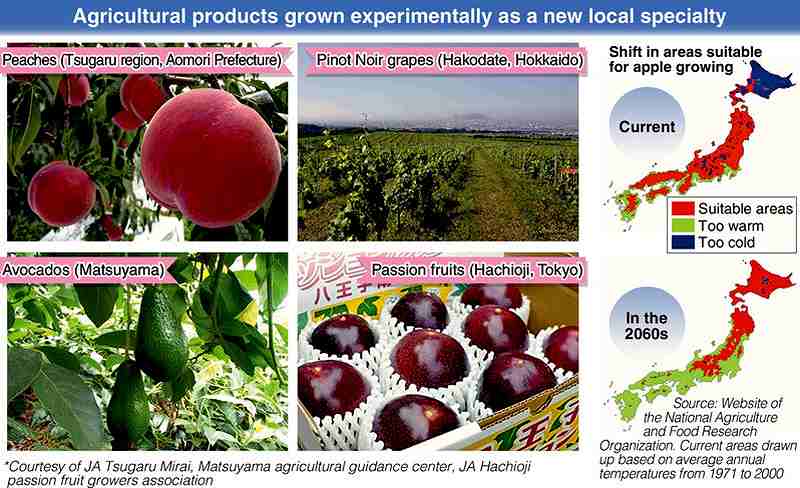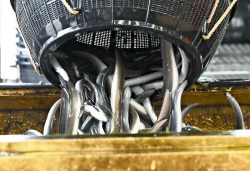
21:48 JST, March 20, 2022
As a fruit normally found in the subtropics grows in Tokyo, peaches are cultivated in Aomori, the prefecture known as “the apple kingdom.”
The country is seeing more and more of these unusual combinations as an offshoot of rising global temperatures. While some may regard it as a “blessing” of global warming, it is not all that simple in terms of the future of the nation’s agriculture.
In Hachioji, western Tokyo, a company is promoting its newest commodity with the catchphrase “Get a taste of the tropics in Tokyo.” The product is passion fruit, which originally comes from subtropical regions in South America.
The fruit had previously grown in Japan, mainly in Kagoshima Prefecture and on the Ogasawara Islands, before full-fledged cultivation started in Hachioji around 2013. A young farmer grew it for its vine to add greenery to an urban area, only to unexpectedly find that the fruit could flourish in Tokyo. That prompted wider production as commercial produce.
The fruit, which features a reddish purple hue and is about the size of a chicken egg, is known for its distinctive combination of sweet and sour taste. The local agricultural cooperative JA Hachioji sees prospects for marketing the fruit as a “local specialty” of Tokyo.
In vast expanses of the north, climate change is resulting in a wine-producing boom.
Due to its cold climate, Hokkaido had been limited to such relatively minor grape varieties as Zweigelt and Kerner. But the average temperature in Sapporo has risen 2.6 C over the past century, and stably hovers above 14 C from April to October. That has enabled cultivation of the popular “Pinot Noir” grape variety that is used for the high-end wine Romanee-Conti.
Seeing future potential in Hokkaido, the distinguished French winery Domaine de Montille has established a foothold. It planted a vineyard on a hillside overlooking the Tsugaru Strait in 2019, with shipments expected to start in 2025.
Unprecedented pace
Based solely on these cases, global warming may not seem such a bad thing. The global environment goes through changes every few centuries, and some theorize that it was colder during the Edo period (1603-1867) than now, and temperatures were higher from the Heian to Kamakura periods (794-1333).
It can be said that rising temperatures in recent years may be within a permissible range. Even so, a strong sense of crisis over global warming caused by greenhouse gases persists because of the unprecedented pace in human history at which temperatures are rising.
According to the Japan Meteorological Agency, current average temperatures in Japan are 1.3 C higher compared with 100 years ago. If nothing is done to impede the progress of global warming, at this rate the average temperature could rise as much as 4.5 C by the start of the 22nd century in 80 years time. The Japanese archipelago will have a climate akin to a subtropical zone.
Naturally, the impact on agriculture will be huge. Projections by the National Agriculture and Food Research Organization (NARO) show that in the 2060s, the prime region for growing apples will shift north from the Tohoku region to Hokkaido. The Tohoku region will be better suited for the popular “Unshu Mikan” variety of mandarin oranges, currently a local specialty in Ehime and Wakayama prefectures far to the south.
From apples to peaches
Based on such projections, the Agriculture, Forestry and Fisheries Ministry drew up a “climate change adaptation project” in 2015, and farming communities across the country have been making efforts to transition to other agricultural products.
One such attempt is the growing of peaches in Aomori Prefecture. Apple growing in Aomori dates back to the early Meiji era (1868-1912), and the prefecture commands a nearly 60% domestic market share with annual shipments of about 440,000 tons.
However, scorching summers in recent years has resulted in alarming damage, as the apples develop sunburn-like spots on the peel and premature ripening leaves them soft.
In light of this, the peach has been targeted as the next-generation product. This is because of the similarities in cultivating the two fruits, as peach trees are almost the same height as apple trees, and the ways they are pruned and maintained to ensure proper coloring of the fruit are congruous.
The growing of peaches in the Tsugaru region started around 2004 with about a dozen farming households, and that number has since grown to about 60. They are also experimenting with processed goods such as ice cream and cake using peaches.
All the while, there are mixed feelings considering the grueling years of effort put in by their predecessors as they produced the “Tsugaru” and “Fuji” apple varieties that have earned a vaunted place among fruits.
“We want to respect our tradition, but we also have to protect the futures of our farming households,” said JA Tsugaru Mirai’s Nodoka Hisatsuka, 36, who advises on the cultivation of peaches.
The “Tsugaru peach” has become a symbol of Japanese agriculture standing at a crossroads.
Importance of improving strains
Together with transitioning to different crops, it is important to improve plant strains in an attempt to cope with climate change. Historically speaking, the typical crop that has been altered in Japan to adapt to changing climate has been rice.
Rice had been cultivated from ancient times across a wide expanse, from Kyushu to the Tohoku region, and even spread to Hokkaido in the Meiji era. But rice strains in those days did not hold up well against the cold, with rice grown in Tohoku and Hokkaido occasionally damaged by frigid weather.
That led to the tweaking of rice strains to produce the cold-tolerant “Hitomebore” and “Nanatsuboshi” brands that are popular today. Both Tohoku and Hokkaido became leading rice-producers, and account for a combined 35% of the domestic market.
Conversely, rice strains that can grow in high temperatures are currently drawing attention. The “Kinumusume” and “Nikomaru” brands developed by the National Agriculture and Food Research Organization are expected to stand up even to hot spells in summer. Others have been developed by local governments, such as the “Genki-tsukushi” in Fukuoka Prefecture and the “Saga-biyori” in Saga Prefecture.
Attention is also falling on other agricultural products, such as a strawberry variety called “Natsu-no-Kagayaki” that is resistant to heat and blight, and a lettuce called “Tough V” that will grow steadily even in a heat wave.
Yet, even if changes are made to the product grown or the strains used, it will take some time to take hold and establish a recognized brand.
“Starting a new variety also requires a financial investment,” said Toshihiko Sugiura, a senior researcher at NARO’s Institute of Fruit Tree and Tea Science. “As farming families continue to age, it is necessary for the country as a whole to address the problem.”
"Science & Nature" POPULAR ARTICLE
-

Genome Study Reveals Milestone in History of Cat Domestication
-

Big Leap in Quest to Get to Bottom of Climate Ice Mystery
-

Security Camera Footage Vulnerable to Outside Access; Investigation Finds 3,000 Pieces Exposed Online
-

Paws on Parade: Nairobi’s Dogs Dazzle at ‘Pawchella’
-

Japanese Eels Escape New Regulation in Vote at CITES Meeting, Avoiding Higher Prices for Dealers and Diners
JN ACCESS RANKING
-

Keidanren Chairman Yoshinobu Tsutsui Visits Kashiwazaki-Kariwa Nuclear Power Plant; Inspects New Emergency Safety System
-

Imports of Rare Earths from China Facing Delays, May Be Caused by Deterioration of Japan-China Relations
-

University of Tokyo Professor Discusses Japanese Economic Security in Interview Ahead of Forum
-

Japan Pulls out of Vietnam Nuclear Project, Complicating Hanoi’s Power Plans
-

Govt Aims to Expand NISA Program Lineup, Abolish Age Restriction

























